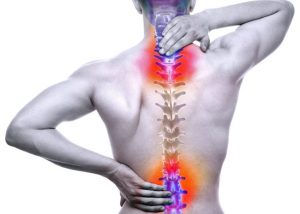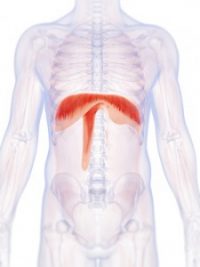
The spinal cord extends from the base of the brain downward, so at any point along the spinal cord, direct or indirect damage can result in spinal cord injury.
When either direct (such as trauma) or indirect damage (from disease or indirect trauma) of the spinal cord occurs, immediate medical attention is required to avoid long-term negative side effects as much as possible, especially because, unlike other parts of the body, once damaged the spinal cord cannot repair itself.
A spinal cord injury is considered a medical emergency, and ensuring a spinal cord injury victim is breathing and has a heartbeat is the first priority, followed by immobilization of the victim.
Symptoms of a Spinal Cord Injury
Depending on where the spinal cord is injured and what kind of injury it is, a spinal cord injury victim may experience any number of symptoms. Symptoms can include loss of function or sensation, muscle weakness, and loss of control of the bowels and bladder.
If the injury occurs in the upper neck of the spinal cord, breathing can be affected, which may require the use of a ventilator.
If the injury occurs at other parts of the spinal cord, certain parts of the body may or may not be affected. This can be determined with a thorough examination by a physician.
Diagnosing a Spinal Cord Injury
Time is of the essence when a patient suffers a medical emergency such as a spinal cord injury. The quicker the treatment is applied to a patient, the more likely the patient is to recover partially or fully.
A physician will need to check a patient’s medical history for any previous injuries or surgeries, medical conditions, or the presence of pain. In addition, a physician will need to obtain details about the time of injury to determine the full scope of the spinal cord injury. A physical examination will also help to diagnose a spinal cord injury, as well as where it occurred along the spinal column and the extent of the damage.
Often, a physician will test a spinal cord injury patient’s sensation and muscle strength. Further examination through x-rays and other scans, such as CT scans and MRIs, will be needed to identify internal injuries to the spine or spinal cord from fractures of the vertebrae, soft tissue damage, tumors, infections, or conditions such as arthritis, HIV, polio, spina bifida, and more.
Immediately After a Spinal Cord Injury
First and foremost, is of the utmost importance to ensure that a patient is breathing and has a heartbeat after suffering a spinal cord injury.
Next, a spinal cord injury patient should be immobilized, usually with a cervical collar or on a backboard, which will help to prevent further damage to the spine from moving. The patient will most likely be kept immobilized until a physician is able to determine if a spinal cord injury actually occurred or not.
Once diagnosed and immediately treated, long-term treatment is necessary for spinal cord injury patients.
Long-term Treatment of a Spinal Cord Injury
To start, medication, such as corticosteroids, may be prescribed to reduce swelling and inflammation associated with a spinal cord injury.
Surgery may be required for certain spinal cord injury victims. Surgery may be needed to relieve pressure on the spine due to compression from broken vertebrae, a tumor, infection, or other causes. Surgery may also stabilize the spine by implanting screws, rods, and/or plates to hold the vertebrae together while the spine heals.
After initial treatment, long-term treatment of a spinal cord injury focuses on rehabilitation of the patient, which includes receiving care from nurses, therapists, nutritionists, psychologists, and more.
Physical therapy can help the spinal cord injury patient strengthen and stretch the muscles that are affected. Physical therapy can also help train patients on how to use assistive devices, such as walkers and wheelchairs, as well as how to manage side effects from spinal cord injuries, such as pain and muscle spasms.
Occupational therapy helps spinal cord injury patients relearn everyday tasks and movements, as well as helps the patient to regain some form of muscle control.
These therapies, along with general rehabilitation after a spinal cord injury will maximize the patient’s recovery, especially since the majority of spinal cord injury recovery happens within the first six months after the injury. After a year, any remaining loss of function is more likely to be permanent.
If a spinal cord injury results in temporary or permanent paralysis, special medical attention may be needed to prevent pressure sores from being bedridden, as well as to prevent urinary problems, pneumonia, blood clots, and mental illness. Appropriate care may help reduce the risk of additional injury or complications associated with spinal cord injuries.
In addition to physical rehabilitation, counseling and support systems like friends and family are just as important to help reduce the chances of mental illness associated with spinal cord injuries, such as depression and loss of self-esteem.
Living with a Spinal Cord Injury
Medical technology has come a long way to help those living with a spinal cord injury. Assistive devices, such as wheelchairs and walkers, can help spinal cord injury patients to remain active in society and life in general. However, at this time there is no cure for spinal cord injury, although doctors and scientists around the world continue to work on finding a cure.
Therefore, in addition to the medical treatment described above, a positive mental outlook is also important for spinal cord injury patients. Remaining an active member of society and learning to function with a spinal cord injury will aid in maintaining a positive outlook. In addition, friends, family, and support groups are all available to help patients cope with their spinal cord injury.
References:
http://www.mayoclinic.org/diseases-conditions/spinal-cord-injury/basics/treatment/con-20023837
http://www.medicinenet.com/spinal_cord_injury_treatments_and_rehabilitation/article.htm
https://www.nichd.nih.gov/health/topics/spinalinjury/conditioninfo/Pages/treatments.aspx



